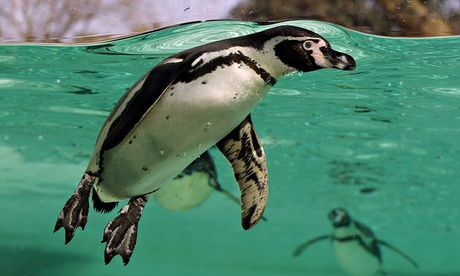From
replacing old pipes to developing water efficiencies in the penguin and
Komodo Dragon enclosures, a mix of people and technology have led to
big water savings
Freddie Romaniuk
Guardian Professional,

Streamlining water management was essential and the first step was to define water use and consumption patterns in order to work out a strategy for saving water and saving money.
For a zoo, the main area of water usage is unsurprisingly animal welfare, including cleaning, replenishing ponds and moats. The water management systems inherited from the early days of the zoo had had not been constructed with sustainability in mind. With more than 3,000 metres of cast iron Victorian water mains covering an area of more than 36 acres, a major issue was the potential loss of water through leakage.
My brief as water management lead was to come up with a clear strategy to make water use more efficient and to be able to measure the benefits of the initiatives for both water supply and wastewater disposal.
The strategies developed and implemented at the zoo have saved more than £1m since 1995. Moreover, the annual water charge today is only 5.9% higher than 12 years ago. This figure is more significant considering that from 2002 to 2014 the mean cost per square cubic metre of water charged to ZSL has increased by 103.1%.
The initial phase was the introduction of Automatic Meter Reader (AMR), equipment that measures water flow. By mapping out the whole zoo area into manageable zones, we were able to investigate the water use within a given area and identify leaks. This method resulted in reducing external leak detection costs by 90% and improved detection rates.
The AMR data supported the implementation of low cost, or no cost, water saving solutions. For example, we installed 21 water control units in the toilets which operated on an occupancy only basis, saving an estimated 8,000m³ a year. AMR data allowed us to analyse the impact of these initiatives and prepare management reports detailing financial savings and highlighting impact versus cost. These reports have become the basis of assessing the success of the water initiatives implemented and the setting of future targets to available budget.
The water requirements for new exhibits are greater than before, as they become ever larger. It’s therefore critical that the long term sustainable water use is addressed. A recent example is the £700,000 Penguin Beach built in 2011. The water capacity of the exhibit has increased tenfold to 450m³, compared to the previous Lubetkin Penguin Pool built in 1934, which has improved animal welfare and visitor experience. To manage the increased water use in a sustainable way, the zoo installed a water filtration and treatment system in the new exhibit, saving 6,000m³ a year. Similar systems have been used in other upgrades of exhibits and water sustainability systems are now planned into all new projects.
Since 1995 more than 700 metres of water mains at London Zoo have been methodically replaced. Staff have been involved too, in the form of programmes such as the Green Fund (an internal initiative), which ask employees to make water and energy saving suggestions. The first exhibit to be awarded green funding has been the Komodo Dragon enclosure. The keepers identified that modifications to the pond would assist them in the management of the enclosure. A couple of options are under consideration with water savings estimated to be in the region of 1,500m³ per annum.
Government policy also helps incentivise businesses to make efficiencies when it comes to water use, allowing them to claim through a scheme which provides tax relief on their investments in water-efficient plant and machinery.
The combination of people and technology has proven to be the best approach for the ZSL, along with awareness campaigns and training. The process has made staff members conscious of their impact on water use and more engaged with its preservation.
Freddie Romaniuk, is the water management lead, ZSL London Zoo and Whipsnade Zoo will speak at The Water Event 2014 on 16 September at the NEC Birmingham
source


















No comments:
Post a Comment